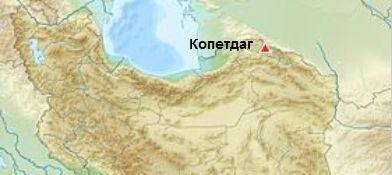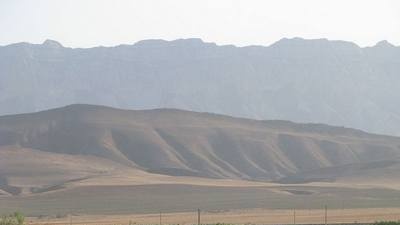|
 Kopetdag reserve is located in the south of Turkmenistan. One of the main tasks facing the staff of the reserve and its scientists is mapping. It cannot be said that these places are poorly studied and have "blank spots", all kinds of expeditions have come here for a long time. Scientists knew a lot about the animal kingdom, the territory that had become a reserve. Kopetdag reserve is located in the south of Turkmenistan. One of the main tasks facing the staff of the reserve and its scientists is mapping. It cannot be said that these places are poorly studied and have "blank spots", all kinds of expeditions have come here for a long time. Scientists knew a lot about the animal kingdom, the territory that had become a reserve.
A detailed map was required in order to more clearly know who lives where, and what grows where. It was impossible to miss any of the most ordinary-looking grass, not a single inhabitant of the reserve, they all had to be counted. The mapping and inventory of protected resources are inseparable.
 This work brought many surprises. It was known that there are pistachios in the Kopetdag mountains, but no one knew that these trees in places grow in whole groves. And their age is very respectable - it has long passed for a hundred years. Herpetologists have found lizards that have not been met here before. Botanists have counted about 1400 plant species, more than a hundred of which are endemic. Wealth is determined by a wide variety of natural areas of the reserve - there are juniper forests, alpine meadows, lifeless dunes, impregnable rocks, spacious valleys. The northern border of the reserve begins where the flaming Karakum desert ends its long run. This mighty Kopet-Dag stopped their heat with its steep slopes. Here gazelle and bezoar goat, sand boa and cobra coexist. Saksaul and juniper. There are about 50 species of reptiles alone. Among them there are also very rare, poorly studied - the Turkmen Eublefar. But the reserve is famous not only for its rarity and diversity, it is also rich in quantity. This work brought many surprises. It was known that there are pistachios in the Kopetdag mountains, but no one knew that these trees in places grow in whole groves. And their age is very respectable - it has long passed for a hundred years. Herpetologists have found lizards that have not been met here before. Botanists have counted about 1400 plant species, more than a hundred of which are endemic. Wealth is determined by a wide variety of natural areas of the reserve - there are juniper forests, alpine meadows, lifeless dunes, impregnable rocks, spacious valleys. The northern border of the reserve begins where the flaming Karakum desert ends its long run. This mighty Kopet-Dag stopped their heat with its steep slopes. Here gazelle and bezoar goat, sand boa and cobra coexist. Saksaul and juniper. There are about 50 species of reptiles alone. Among them there are also very rare, poorly studied - the Turkmen Eublefar. But the reserve is famous not only for its rarity and diversity, it is also rich in quantity.
Now it is difficult to find a place where there would be a lot of gyurz and cobras. They are quite common here. This made it possible to organize a snake nursery at the central estate of the reserve.
Taking poison from snakes requires from people maximum endurance, great concentration, considerable strength, and excellent reaction. They do it slowly. They open a cage with a poisonous captive. The herpetologist takes out a "hissing spiral" with a long hook and carries it to the table. Here it is difficult to resist, the polished surface hinders movement, does not allow making a throw. People lightly press her head against the table with a ruler and take it in their hands. Then they give me a bite of a special cup. At this time, through the wires installed in the snake's mouth, current flows from the battery to the mucous membrane. And yellow drops of poison run down the teeth into the cup.
After this procedure, the snake is transferred to a bath with potassium permanganate. This is a necessary disinfection. And again they put her in a cage.
In the Kopetdag reserve, poison is taken only in the warm season. For the winter, the nursery is closed, gyurza and cobras are set free, they are released in the places where they were caught. At home, they winter better, gain strength. And in the spring, herpetologists again go to Kopetdag for snakes.
The staff of the reserve catch not only gurz and cobras. They also went to Badkhyz for the kulans. Now the settlers feel quite well in their new place. They had offspring. Reaclimatization carried out by the scientists of the Kopetdag reserve was a success. Now in Turkmenistan live the rarest animal lands included in the international Red Book - kulans.
 In general, there are enough representatives of the protection book in the reserve - leopard, gazelle, caracal. Scientists are constantly watching them. In general, there are enough representatives of the protection book in the reserve - leopard, gazelle, caracal. Scientists are constantly watching them.
However, no one is offended by the attention here. Take the long-legged skink, a lizard with smooth black scales. What could be interesting in her life for scientists? It turns out that the skink is quite useful. It feeds on pollen eaters, and prefers these insects in spring, when everything is in bloom.In the summer he switches to other food - in his diet locusts, cookies, scorpions. For the winter, the skink buries itself in the sand and waits out the cold there. In order to better know the attachment to habitats, changes in weight and size, skinks are tagged in the reserve. "Certification" makes it possible to learn more about the life of the marked animal.
Scientists have done a lot since the establishment of the reserve. They recognized all the juniper forests, identified the dominant and rare birds, discovered the favorite gorges of argali, calculated the density of the plant, and conducted a survey of wild animals. Now they know who lives in their reserve, where it is easier to meet the desired animal, where birds build nests, where turtles hide for the winter, on which slope after winter the tulips light up the first lights.
Oksana Nikolaevna. Image Credits Anielewicz and Uwe Dedering (Creative Commons License)
|
 Kopetdag reserve is located in the south of Turkmenistan. One of the main tasks facing the staff of the reserve and its scientists is mapping. It cannot be said that these places are poorly studied and have "blank spots", all kinds of expeditions have come here for a long time. Scientists knew a lot about the animal kingdom, the territory that had become a reserve.
Kopetdag reserve is located in the south of Turkmenistan. One of the main tasks facing the staff of the reserve and its scientists is mapping. It cannot be said that these places are poorly studied and have "blank spots", all kinds of expeditions have come here for a long time. Scientists knew a lot about the animal kingdom, the territory that had become a reserve.
 This work brought many surprises. It was known that there are pistachios in the Kopetdag mountains, but no one knew that these trees in places grow in whole groves. And their age is very respectable - it has long passed for a hundred years. Herpetologists have found lizards that have not been met here before. Botanists have counted about 1400 plant species, more than a hundred of which are endemic. Wealth is determined by a wide variety of natural areas of the reserve - there are juniper forests, alpine meadows, lifeless dunes, impregnable rocks, spacious valleys. The northern border of the reserve begins where the flaming Karakum desert ends its long run. This mighty Kopet-Dag stopped their heat with its steep slopes. Here gazelle and bezoar goat, sand boa and cobra coexist. Saksaul and juniper. There are about 50 species of reptiles alone. Among them there are also very rare, poorly studied - the Turkmen Eublefar. But the reserve is famous not only for its rarity and diversity, it is also rich in quantity.
This work brought many surprises. It was known that there are pistachios in the Kopetdag mountains, but no one knew that these trees in places grow in whole groves. And their age is very respectable - it has long passed for a hundred years. Herpetologists have found lizards that have not been met here before. Botanists have counted about 1400 plant species, more than a hundred of which are endemic. Wealth is determined by a wide variety of natural areas of the reserve - there are juniper forests, alpine meadows, lifeless dunes, impregnable rocks, spacious valleys. The northern border of the reserve begins where the flaming Karakum desert ends its long run. This mighty Kopet-Dag stopped their heat with its steep slopes. Here gazelle and bezoar goat, sand boa and cobra coexist. Saksaul and juniper. There are about 50 species of reptiles alone. Among them there are also very rare, poorly studied - the Turkmen Eublefar. But the reserve is famous not only for its rarity and diversity, it is also rich in quantity.




